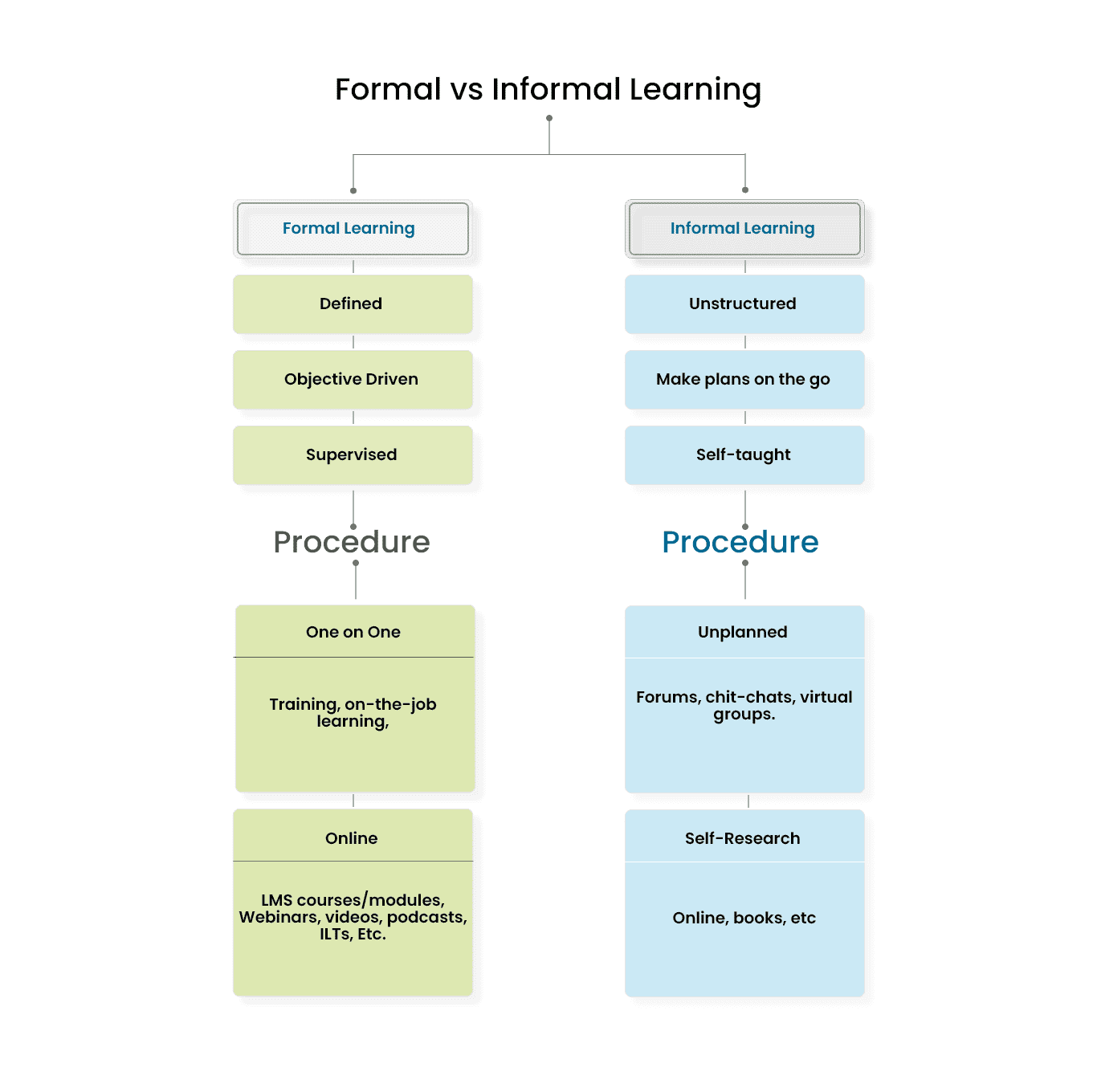What is formal and informal learning?
Learning that is “given in a systematic planned fashion” is referred to as formal learning. It typically takes place in a face-to-face environment or through an online learning platform, like an LMS, and is planned and supervised by an instructor. For example, consider formal training in the context of new hire onboarding or compliance training in the workplace. These kinds of training require organization, have due dates, and have a clear objective.
At the other end of the spectrum comes informal education. It’s unstructured, frequently unintentional, and takes place outside a typical learning environment. Importantly, it is spontaneous, asynchronous, and self-directed; no simple goals are involved. It may occur whenever and everywhere in your company.
For instance, a coworker may tell you during a conversation that she has discovered a more practical approach to automating a manual process that you may also employ. Even though it wasn’t intentional, you still gained knowledge.
Formal or Informal Learning? Which one to choose?
Choosing between formal and informal ways to learn can be challenging. For instance, online training in law, health, safety, and security is often done formally. On the other hand, online training for customer service, software, or product knowledge may not be formal.
But this is just the beginning of a plan that doesn’t work. Sometimes, the most boring topics call for the most creative ways to deal with them. So, what should you put in your next eLearning course? Think about the five questions below:
-
What formal training materials should I cover, like text, video, audio, or graphics?
How, for example, will online training materials help learners reach their goals and improve their skills? How will it meet the needs of business people who want to learn? How can you add informal learning to this task to help you remember it better?
-
Where can I add a social part to the content? What social media sites do online students use often, and how can you get them to join?
Will watching YouTube videos, for example, get kids to talk to others in the comments or maybe even make videos to share with their friends? Or is the subject matter better suited for blog posts that make you think?
-
Is there a way to enhance the online training experience by adding non-formal games or simulations?
Remember that every online training exercise should help you reach your goals and not just be fun.
-
Is one method better for some topics or tasks than another?
Should you, for example, keep teaching your online course on “safe handling practices” in a more formal way to prevent compliance violations? If so, you might be able to improve their practical experience by adding just-in-time materials to the planned activity or online training course.
-
Is it possible to use microlearning as part of this course?
Make a library of microlearning resources, like short blog posts or group discussions, that corporate learners can use at any time.
Informal learning methods
As informal learning is organic and unplanned, it’s hard to pinpoint how your organization uses it. However, informal learning is happening in your company. Maybe you’re unaware. Learning occurs when an employee Googles methods to improve a procedure or when coworkers discuss a task. However, you may foster informal learning in your workplace. Creating a pool of resources for employees to use as needed supports informal learning. Social learning, whether face-to-face talks, a messaging software like Slack, or an LMS forum, boosts employee learning.
When are formal and informal learning techniques appropriate?
Formal and informal learning aren’t mutually incompatible in business learning methodologies. Each has benefits and roles in your company. Just use the correct procedure. There are rules for choosing the right one. Is the training measurable? Yes, for compliance, onboarding, job, soft, and product training.
These courses impact your business’s success, so ensuring your employees have the knowledge they need to do their jobs well is an important metric to track. Informal learning is often used for “good to know” content.
Nurture conversations and encourage autonomous learning so employees may learn on their own. You decide what knowledge processes your organization needs. Successful firms prioritize learning in whatever form.
Combining informal methods with formal training
Online training is available 24/7. Corporate learners can choose how to interact with training information. How can you hold their attention?
Corporate training has to engage business learners with engaging training content and design. Else they lose the learner’s attention. Blended learning is most effective when informal methods reinforce formal components.
Adding everyday learning aspects lets corporate learners practice securely and more precisely. They can absorb information and then try (and fail) risk-free. They can also learn from their colleagues outside of formal instruction.
Conclusion
Formal training has a place in an organization’s performance support framework. However, informal learning support is an addition to formal programs, not a replacement. As learning and performance professionals, we must master performance support.
Thanks to the integrated approach to eLearning, users can feel at ease in their surroundings while engaging in learning in a real-world setting. You may freshly approach design considerations if you can get that blend for your training content just right.
Every online training course you create should try to include a variety of methodologies in a balanced way. But, of course, it’s up to you to decide. Keep in mind that it’s crucial to cater to everyone’s preferences in online training.












